Pushing the Boundaries of Life: Tropics
Warming Winds, Rising Tides: Oceans
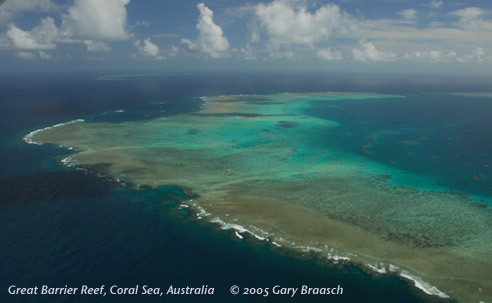
Update: 2010 Brings Another Severe Bleaching to the World's Coral.
Ocean temperatures in the western Pacific and the Caribbean are extraordinarily high throughout most of 2010, another reminder that global warming's effects are continuing. In the Caribbean, they are even worse than those of 2005 which bleached and damaged so much of the coral there, including endangered coral species in Virgin Islands National Park. See details about bleaching and the areas affected previously, below.
Information, alerts and maps for current conditions are available from NOAA at http://coralreefwatch.noaa.gov/satellite/baa/index.html and from the Smithsonian, at http://www.eurekalert.org/pub_releases/2010-10/stri-srr101210.php and Science journal, at http://news.sciencemag.org/sciencenow/2010/10/caribbean-coral-die-off-could-be.html
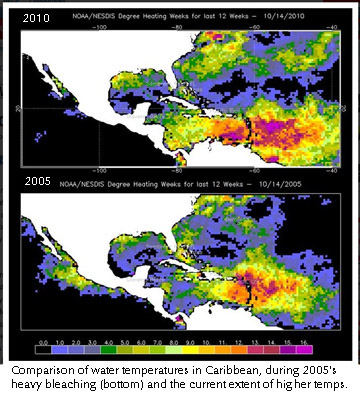
Coral reefs are probably the most complex ecosystems on the planet, home to hundreds of thousands of species. Reefs offer coastal protection to eighty-six nations, as well as income estimated at $375 billion through fishing, recreational opportunities, and new drugs. The damage being caused to reefs and the open ocean is one of the most serious effects of global warming.
These images are of the Great Barrier Reef, the largest reef on the planet and probably the most complex ecosystem, home to hundreds of thousands of species ranging from sharks to bacteria. Reefs are made of the calcium carbonate skeletons of the colonial coral polyp and as such represent a cycling, balance and storage of carbon. Climate change now threatens the ocean and corals in particular in two ways. First, oceans have warmed as much as a degree above the normal only a half century ago.
Second, oceans are getting more acidic because they naturally absorb CO2, including about a third of human-made emissions. This is creating a rapid, dangerous change in water chemistry that can slow or reverse shell and coral growth. Slower growth is already seen on some reefs, and tiny plankton – base of the food chain and source of half of Earth’s oxygen – will also be damaged as CO2 increases. For more information from a scientific paper about the threat to coral reefs, please see.
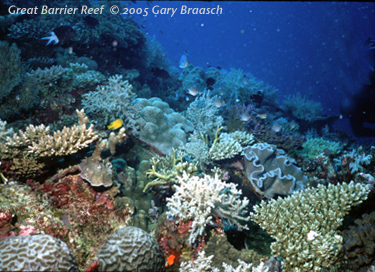
Rising sea temperature coupled with the strong El Nino of 1998 was devastating to much of the world's coral reefs. High water temperatures caused coral bleaching and subsequent death or adverse change to sixteen percent of world reefs overall and up to 46 percent in parts of the Indian Ocean.
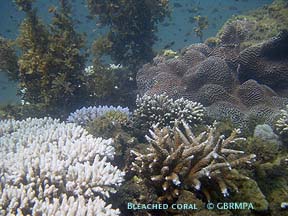
Temperatures beyond norms causes coral to expel the microscopic symbionts, zooxanthellae, that also give them color. If this bleaching continues for days to weeks, the coral dies and algae takes over the reefs, changing the ecosystem. During another bout of bleaching in 2002, the international coral reef information network ReefBase reported 430 cases of coral bleaching, most of them on the Great Barrier Reef, the world's largest. Bleaching was also very extensive in the U.S. Virgin Islands National Park during 2005.
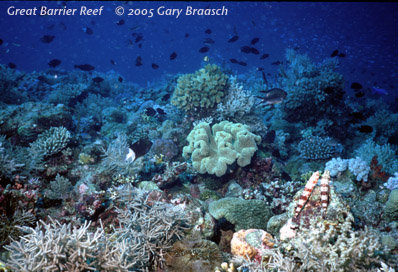
As it takes up heat, ocean water expands -- the major cause of sea level rising at a rate now exceeding 8 inches a century. Sea level rose about 6 inches in the 20th century, but the rise is predicted to increase to as much as a meter by 2100 (see Coastlines and Glacier sections). Coral, which thrives at and near the sea surface, is not expected to be able to keep pace with this rapid increase in water depth. In addition, seas are dissolving more and more carbon dioxide. Even though this adds more carbon, a raw material for coral making calcium carbonate reefs, it also acidifies the water, actually inhibiting the growth of coral.
Coupled with damage from human activities and development,
this growing danger has lead some scientists to predict the end of reefs
across much of the ocean. In reports in 1999 and 2004, Australian
Marine Biologist Ove Hoegh-Guldberg and others said high water temperatures
and bleaching will become yearly events before mid-century. Living
coral may be reduced by 95 percent on the Great Barrier Reef. Hough-Guldberg
said recently, "We are damaging a large part of the world's biodiversity"
on the reefs. "We're 'chopping them down' with global warming.
These reefs will be so changed that we'll have to find ways to re-employ
all those people," the millions who depend directly on reef fisheries
and recreation. "The implications are huge."
For a current report on a Pacific Island nation that is threatened by
higher sea levels, and other places that are being inundated, see Coastlines.
For a look at climate-driven events in the North Atlantic, see the Arctic section.
"Sez who?": References 4 and References 7
Each of the foregoing photos reports on documented science, peer-reviewed published studies and scientific literature surveys. Those references are listed later in this Web site, along with climate change data, World View of Global Warming project advisors, and links to some sources of climate information.
COPYRIGHT NOTICE:
Photography and text Copyright © 2005 - 2017 (and before) Gary Braasch All rights reserved. Use of photographs in any manner without permission is prohibited by US copyright law. Photography is available for license to publications and other uses. Please contact requestinformation@worldviewofglobalwarming.org. View more of Gary Braasch's photography here.


